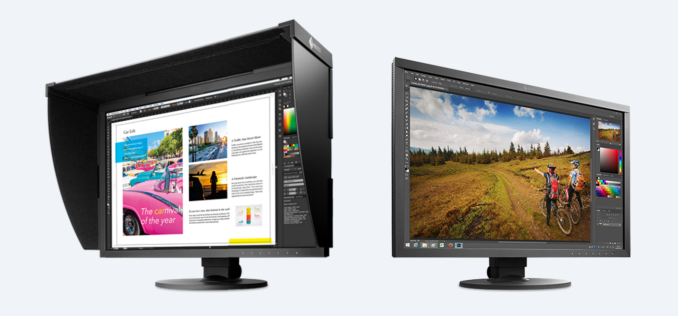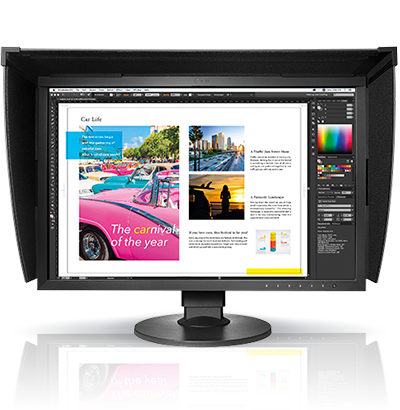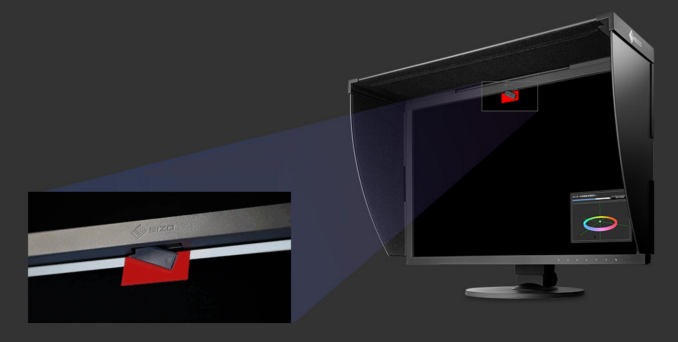16:10 Lives On: EIZO Releases 24-inch ColorEdge CG2420 and CS2420 Professional Monitors
by Ian Cutress on February 16, 2016 8:30 AM EST
For anyone that loves a 16:10 screen, with resolutions such as 1920x1200 or 2560x1600, there have been relatively slim pickings in the monitor world recently. Any high end or high refresh rate monitor is likely to be of the 16:9 variety (1920x1080, 2560x1440 or 3840x2160) or a 21:9 unit through the ultra-wide 2560x1080 or 3440x1440 monitors. One of the reasons as to why companies who make high end monitors do not produce many 16:10 units was given to me by ASUS: there are simply not enough companies producing the panels. It seems that EIZO has managed to find a couple though, with their new ColorEdge displays.
| EIZO ColorEdge | ||||||
| CG2420 | CS2420 | |||||
| Video Inputs | DVI-D with HDCP DisplayPort with HDCP HDMI with HDCP, Deep Color |
|||||
| Panel Type | IPS with Wide-Gamut LED | |||||
| Pixel Pitch | 0.270 mm | |||||
| Colors | DisplayPort: 1.07 billion from 278 trillion HDMI: 1.07 billion from 278 trillion DVI-D: 16.77 million from 278 trillion |
|||||
| Greyscale | DisplayPort: 1024 tones from 65k tones HDMI: 1024 tones from 65k tones DVI-D: 256 tones from 65k tones |
|||||
| Gamut | AdobeRGB: 99% DCI-P3: 98% |
AdobeRGB: 99% | ||||
| Brightness | 400 cd/m2 | 350 cd/m2 | ||||
| Contrast Ratio | 1500:1 | 1000:1 | ||||
| Response Time | 10 ms (gray-to-gray) | 15ms (gray-to-gray) | ||||
| Viewable Size | 24.1-inch (61cm) | |||||
| Resolution | 1920 x 1200 at 60 Hz | |||||
| Viewing Angle | 178°/178° | |||||
| Backlight | Wide-Gamut LED | |||||
| Screen Treatment | Anti-Glare | |||||
| Height Adjustable | 155 mm | |||||
| Tilt | -5° to +35° | |||||
| Swivel | 344° | |||||
| VESA Wall Mounting | 100 x 100 mm | |||||
| Dimensions w/Stand at maximum height |
554.4 x 551 x 245 mm | |||||
| Power Consumption | <0.7W Power Save 20W Typical 79W Peak |
<0.7W Power Save 26W Typical 92W Peak |
||||
| Weight | 8.5 kg / 18.7 lb with Hood | 7.8 kg / 17.2 lb | ||||
| Additional Features | 3-port USB 3.0 Hub Color Adjustment Sensor USB Charge Port |
3-port USB 3.0 Hub USB Charge Port |
||||
| Accessories | Signal Cables (DVI-D, mDP to DP) USB Cable Utility Disk |
|||||
| Warranty | 5 Years / 30k hours Parts 10k hours color (under 120cd/m2) |
|||||
So admittedly these are not particularly consumer style monitors, and EIZO states that they are aimed at the creative industries rather than high refresh rate gaming. The cabinet designs come with a slimmer bezel that EIZO’s previous versions, and come with carrying handles for easier mobility across a working environment. The CG2420 is the higher specification of the two, with a built in self-calibration sensor to maintain color accuracy over time, a higher contrast ratio at 1500:1 and a shading hood as standard.
Both units are 1920x1200 wide-gamut 10-bit IPS non-glare displays but use 16-bit look up tables to do so, and offer DisplayPort, HDMI and DVI digital inputs. The wide gamut aspect means that these panels have 99% AdobeRGB coverage, with the CG2420 panel also covering 98 of the DCI-P3 color space. Unfortunately no Rec. 2020 coverage is specified at this time, as the focus seems to be for DCI-P3. Both monitors also come with EIZO’s custom ColorNavigator 6 software for calibration and a quoted time of 3-minutes for color stabilization from power-on.
Now, of course there will be users wondering why anyone wants a few extra pixels at the bottom, and why it matters. Typical 16:10 enthusiasts are coders and writers that love them for the extra vertical space, ensuring more content is on the screen at the same time. For media processing and consumption, the user can see the full 1920x1080 video on a 1920x1200 screen and still has space for functional buttons on editing or playback, rather than obscuring part of the video or making the content shrink/expand. As much as 16:10 monitors are rare, laptops even more so, which makes me wonder if I can’t go back to my Dell M4400, except that the battery now lasts 2 hours and it weighs 4kg+. Fingers crossed for a 16:10 laptop sometime soon.
EIZO states that these monitors will be shipping from February, although intended markets and pricing are not yet confirmed. Both the CG2420 and CS2420 are backed by a five-year or 30,000 hour (3.4 year) on-time warranty for use and a 10,000 hour warranty on brightness and color.
Source: EIZO



















41 Comments
View All Comments
Samus - Wednesday, February 17, 2016 - link
I agree, 4:3 in laptops makes so much more sense because you get a full-size 6 row keyboard and a larger palmrest/trackpad. 16:10 also provides these benefits by making the display taller, therefor the casing.BurntMyBacon - Tuesday, February 16, 2016 - link
@GodHatesFAQs: "I miss 16:10 very much,"Me too. = ( Me too.
rxzlmn - Tuesday, February 16, 2016 - link
I don't that much. Recently replaced my old 16:10/1920*1200 24" and soon realized there were not many good offerings for that format. Went on to buy a 25" 16:9 with a resolution of 2560*1440. Has the same vertical space, more pixels, and happens to be a bit wider. I don't really see the downside if resolution and size is not fixed.Sunrise089 - Wednesday, February 17, 2016 - link
The issue for me is that the new wider monitor forces me to push it further away in order to not have the image too wide, and then I no longer have the same vertical field of view. I don't have great vision though, so I can see this being less of an issue for others.Bonus concern: 1920x1200 is easier to push native while gaming.
Sivar - Tuesday, February 16, 2016 - link
Get a nice pair of Dell U2415's. I have two at home and two in my office.They are no Eizo's, but they are 16:10 60hz IPS panels with even lighting and good color.
They all ship with a calibration document, but it's more of a calibration measurement. They don't seem to work especially hard to get the color dead-on.
bji - Tuesday, February 16, 2016 - link
I am reading your comment on a Dell U3014. It's the best monitor I've ever used, by far. I have it at work. 30 inch, 2560x1600 resolution, 16:10, beautiful image quality. I think the lag is not great though, although if you care enough about input lag in games you probably just want a cheap 16:9 TN that matches the aspect ratio that most games are expecting anyway.Frenetic Pony - Wednesday, February 17, 2016 - link
Same here, my Surface Pro 3 is fantastic for getting stuff done and I'd love a desktop monitor with a similar aspect ratio. And these sound fantastic, until it comes to the PPI which my SP3 has spoiled me on. If these were 2560x1600 I'd probably buy one this year, but as it is I'd find it hard to go back to big pixels after seeing how good an even relatively high PPI screen can look : /sadsteve - Saturday, February 20, 2016 - link
You don't have to miss them. I've to 2 24in Dells in the 16x10 format. They still carry them so it's up to you.r3loaded - Tuesday, February 16, 2016 - link
Why is it that only Apple seems to consider 16:10 important?Also, I really want a 3840x2400 monitor.
ImSpartacus - Tuesday, February 16, 2016 - link
Everyone else is racing to the bottom.Boutiques like Apple, MS (Surface) and Google (Pixel) sell their products through the image of quality and that lets then increase margins enough to add good stuff like high quality panels.
Meanwhile, if your only value proposition is either the price or the aspie-attracting spec sheet, then you don't have the luxury to spend extra cash on stuff like the panel.